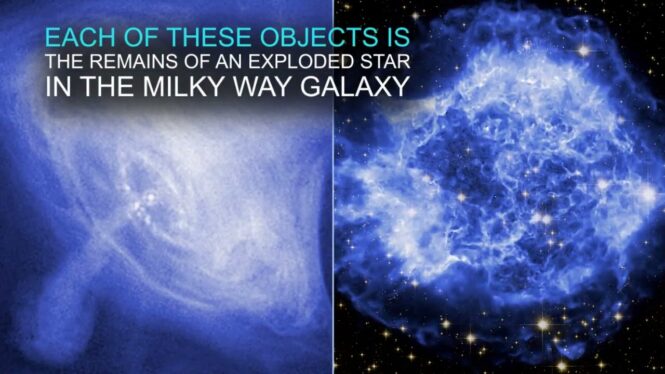New movies of two of the most famous objects in the sky — the Crab Nebula and Cassiopeia A — are being released from NASA’s Chandra X-ray Observatory. Each includes X-ray data collected by Chandra over about two decades. They show dramatic changes in the debris and radiation remaining after the explosion of two massive stars in our galaxy.
The Crab Nebula, the result of a bright supernova explosion seen by Chinese and other astronomers in the year 1054, is 6,500 light-years from Earth. At its center is a neutron star, a super-dense star produced by the supernova. As it rotates at about 30 times per second, its beam of radiation passes over the Earth every orbit, like a cosmic lighthouse.
As the young pulsar slows down, large amounts of energy are injected into its surroundings. In particular, a high-speed wind of matter and anti-matter particles plows into the surrounding nebula, creating a shock wave that forms the expanding ring seen in the movie. Jets from the poles of the pulsar spew X-ray emitting matter and antimatter particles in a direction perpendicular to the ring.
Over 22 years, Chandra has taken many observations of the Crab Nebula. With this long runtime, astronomers see clear changes in both the ring and the jets in the new movie. Previous Chandra movies showed images taken from much shorter time periods — a 5-month period between 2000 and 2001 and over 7 months between 2010 and 2011 for another. The longer timeframe highlights mesmerizing fluctuations, including whip-like variations in the X-ray jet that are only seen in this much longer movie. A new set of Chandra observations will be conducted later this year to follow changes in the jet since the last Chandra data was obtained in early 2022.
Crab Nebula Timelapse
The second billing in this doubleheader is just as spectacular. Cassiopeia A (Cas A for short) is the remains of a supernova that is estimated to have exploded about 340 years ago in Earth’s sky. While other Chandra movies of Cas A have previously been released, including one with data extending from 2000 to 2013, this new movie is substantially longer featuring data from 2000 through to 2019.
The outer region of Cas A shows the expanding blast wave of the explosion. The blast wave is composed of shock waves, similar to the sonic booms generated by a supersonic aircraft. These expanding shock waves are sites where particles are being accelerated to energies that are higher than the most powerful accelerator on Earth, the Large Hadron Collider. As the blast wave travels outwards it encounters surrounding material and slows down, generating a second shock wave that travels backwards relative to the blast wave, analogous to a traffic jam travelling backwards from the scene of an accident on a highway.
Cas A has been one of the most highly observed targets and publicly released images from the Chandra mission. It was Chandra’s official first-light image in 1999 after the Space Shuttle Columbia launched into orbit and quickly discovered a point source of X-rays in Cas A’s center for the first time, later confirmed to be a neutron star. Over the years, astronomers have used Chandra to discover evidence for “superfluid” inside Cas A’s neutron star, to reveal that the original massive star may have turned inside out as it exploded and to take an important step in pinpointing how giant stars explode. Chandra has also mapped the elements forged inside the star, which are now moving into space to help seed the next generation of stars and planets. More recently, Chandra data was combined with data from NASA’s James Webb Space Telescope to help determine the origin of mysterious structures within the remnant.
Cassiopeia A Timelapse
The images used in the latest Cas A movie have been processed using a state-of-the-art processing technique, led by Yusuke from Rikkyo University in Japan, to fully capitalize on Chandra’s sharp X-ray vision. The paper describing their work was published in The Astrophysical Journal and is available online.
These two movies show Chandra’s capabilities of documenting changes in astronomical objects over human timeframes. Such movies would not be possible without Chandra’s archives that serve as public repositories for the data collected over Chandra’s nearly 25 years of operations.
NASA’s Marshall Space Flight Center manages the Chandra program. The Smithsonian Astrophysical Observatory’s Chandra X-ray Center controls science from Cambridge Massachusetts and flight operations from Burlington, Massachusetts.
Read more from NASA’s Chandra X-ray Observatory.
For more Chandra images, multimedia and related materials, visit:
https://www.nasa.gov/mission/chandra-x-ray-observatory/
News Media Contact
Megan Watzke
Chandra X-ray Center
Cambridge, Mass.
617-496-7998
Jonathan Deal
Marshall Space Flight Center
Huntsville, Ala.
256-544-0034
https://www.nasa.gov/missions/chandra/nasas-chandra-releases-doubleheader-of-blockbuster-hits/


